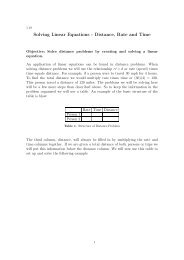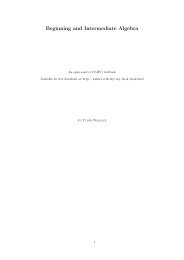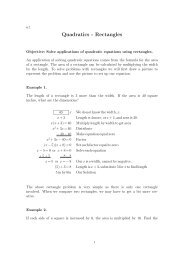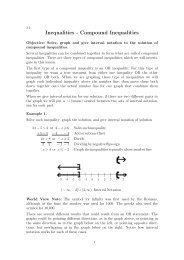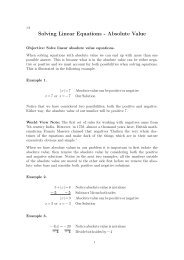You also want an ePaper? Increase the reach of your titles
YUMPU automatically turns print PDFs into web optimized ePapers that Google loves.
8.1<br />
<strong>Radicals</strong> - <strong>Square</strong> <strong>Roots</strong><br />
Objective: Simplify expressions with square roots.<br />
<strong>Square</strong> roots are the most common type of radical used. A square root “unsquares”<br />
a number. For example, because 52 √ = 25 we say the square root of 25 is 5.<br />
The square root of 25 is written as 25.<br />
World View Note: The radical sign, when first used was an R with a line<br />
through the tail, similar to our perscription symbol today. The R came from the<br />
latin, “radix”, which can be translated as “source” or “foundation”. It wasn’t until<br />
the 1500s that our current symbol was first used in Germany (but even then it<br />
was just a check mark with no bar over the numbers!<br />
The following example gives several square roots:<br />
Example 1.<br />
√ √<br />
1 = 1 121 = 11<br />
√ √<br />
4 = 2 625 = 25<br />
√ √<br />
9 = 3 − 81 = Undefined<br />
√<br />
The final example, − 81 is currently undefined as negatives have no square root.<br />
This is because if we square a positive or a negative, the answer will be positive.<br />
Thus we can only take square roots of positive numbers. In another lesson we will<br />
define a method we can use to work with and evaluate negative square roots, but<br />
for now we will simply say they are undefined.<br />
Not all numbers have a nice even square root. For example, if we found 8<br />
√ on<br />
our calculator, the answer would be 2.828427124746190097603377448419... and<br />
even this number is a rounded approximation of the square root. To be as accurate<br />
as possible, we will never use the calculator to find decimal approximations of<br />
square roots. Instead we will express roots in simplest radical form. We will do<br />
this using a property known as the product rule of radicals<br />
√<br />
Product Rule of <strong>Square</strong> <strong>Roots</strong>: a · b<br />
= a<br />
√ · b<br />
√<br />
√<br />
We can use the product rule to simplify an expression such as 36 · 5 by spliting<br />
√ √ √<br />
it into two roots, 36 · 5,<br />
and simplifying the first root, 6 5.<br />
The trick in this<br />
1
√<br />
process is being able to translate a problem like 180<br />
√<br />
into 36 · 5.<br />
There are sev-<br />
eral ways this can be done. The most common and, with a bit of practice, the<br />
fastest method, is to find perfect squares that divide evenly into the radicand, or<br />
number under the radical. This is shown in the next example.<br />
Example 2.<br />
√<br />
75<br />
√<br />
25 · 3<br />
√ √<br />
25 · 3<br />
5 3<br />
√<br />
75 is divisible by 25,aperfect square<br />
Split into factors<br />
Product rule, take the square root of 25<br />
Our Solution<br />
If there is a coefficient in front of the radical to begin with, the problem merely<br />
becomes a big multiplication problem.<br />
Example 3.<br />
√<br />
5 63<br />
√<br />
5 9 · 7<br />
5 9<br />
√ · 7<br />
√<br />
5 · 3 7<br />
√<br />
15 7<br />
√<br />
63 is divisible by 9, a perfect square<br />
Split into factors<br />
Product rule, take the square root of9<br />
Multiply coefficients<br />
Our Solution<br />
As we simplify radicals using this method it is important to be sure our final<br />
answer can be simplified no more.<br />
Example 4.<br />
√<br />
72<br />
√<br />
9 · 8<br />
√<br />
√<br />
9 · 8<br />
3 8<br />
√<br />
√<br />
3 4 · 2<br />
3 4<br />
√ · 2<br />
√<br />
3 · 2 2<br />
√<br />
6 2<br />
√<br />
72 is divisible by 9,aperfect square<br />
Split into factors<br />
Product rule, take the square root of 9<br />
But8is also divisible by a perfect square, 4<br />
Split into factors<br />
Product rule, take the square root of 4<br />
Multiply<br />
Our Solution.<br />
2
The previous example could have been done in fewer steps if we had noticed that<br />
72 = 36 · 2, but often the time it takes to discover the larger perfect square is more<br />
than it would take to simplify in several steps.<br />
Variables often are part of the radicand as well. When taking the square roots of<br />
variables, we can divide the exponent by 2. For example, x8 √<br />
4 = x , because we<br />
divide the exponent of 8 by 2. This follows from the power of a power rule of<br />
expoennts, (x4 ) 2 = x8 . When squaring, we multiply the exponent by two, so when<br />
taking a square root we divide the exponent by 2. This is shown in the following<br />
example.<br />
Example 5.<br />
− 5 9<br />
√ · 2<br />
− 5 18x4y6z 10<br />
�<br />
− 5 9 · 2x4y6z 10<br />
�<br />
√<br />
√ · x4 √<br />
6 · y � · z10 − 5 · 3x2y3z5 2<br />
√<br />
− 15x2y3z5 2<br />
√<br />
18 is divisible by 9,aperfect square<br />
Split into factors<br />
Product rule, simplify roots, divide exponents by 2<br />
Multiply coefficients<br />
Our Solution<br />
We can’t always evenly divide the exponent on a variable by 2. Sometimes we<br />
have a remainder. If there is a remainder, this means the remainder is left inside<br />
the radical, and the whole number part is how many are outside the radical. This<br />
is shown in the following example.<br />
Example 6.<br />
20x5y9z6 �<br />
4 · 5x5y9z6 �<br />
√ √ √<br />
5 9<br />
4 · 5 · x · y � · z6 √<br />
2x2y4z3√ 5xy<br />
20 is divisible by 4, a perfect square<br />
Split into factors<br />
Simplify, divide exponents by 2, remainder is left inside<br />
Our Solution<br />
Beginning and Intermediate Algebra by Tyler Wallace is licensed under a Creative Commons<br />
Attribution 3.0 Unported License. (http://creativecommons.org/licenses/by/3.0/)<br />
3
Simplify.<br />
√<br />
1) 245<br />
√<br />
3) 36<br />
√<br />
5) 12<br />
√<br />
7) 3 12<br />
√<br />
9) 6 128<br />
√<br />
11) − 8 392<br />
√<br />
13) 192n<br />
15) 196v2 √<br />
17) 252x2 √<br />
19) − 100k4 √<br />
21) − 7 64x4 √<br />
√<br />
23) − 5 36m<br />
25) 45x2y2 �<br />
27) 16x3y3 �<br />
29) 320x4y4 �<br />
31) 6 80xy2 �<br />
33) 5 245x2y3 �<br />
35) − 2 180u3 √<br />
v<br />
37) − 8 180x4y2z4 �<br />
39) 2 80hj4 �<br />
k<br />
41) − 4 54mnp2 �<br />
8.1 Practice - <strong>Square</strong> <strong>Roots</strong><br />
√<br />
2) 125<br />
√<br />
4) 196<br />
√<br />
6) 72<br />
√<br />
8) 5 32<br />
√<br />
10) 7 128<br />
√<br />
12) − 7 63<br />
√<br />
14) 343b<br />
16) 100n3 √<br />
18) 200a3 √<br />
20) − 4 175p4 �<br />
√<br />
22) − 2 128n<br />
24) 8 112p2 �<br />
26) 72a3b4 √<br />
28) 512a4b2 √<br />
30) 512m4n3 √<br />
√<br />
32) 8 98mn<br />
34) 2 72x2y2 �<br />
36) − 5 72x3y4 �<br />
38) 6 50a4bc2 √<br />
40) − 32xy2z3 �<br />
42) − 8 32m2p4 �<br />
q<br />
Beginning and Intermediate Algebra by Tyler Wallace is licensed under a Creative Commons<br />
Attribution 3.0 Unported License. (http://creativecommons.org/licenses/by/3.0/)<br />
4
8.1<br />
1) 7 5<br />
√<br />
2) 5 5<br />
√<br />
3) 6<br />
4) 14<br />
5) 2 3<br />
√<br />
6) 6 2<br />
√<br />
7) 6 3<br />
√<br />
8) 20 2<br />
√<br />
9) 48 2<br />
√<br />
10) 56 2<br />
√<br />
11) − 112 2<br />
√<br />
12) − 21 7<br />
√<br />
√<br />
13) 8 3n<br />
√<br />
14) 7 7b<br />
15) 14v<br />
Answers - <strong>Square</strong> <strong>Roots</strong><br />
16) 10n n<br />
√<br />
17) 6x 7<br />
√<br />
√<br />
18) 10a 2a<br />
19) − 10k2 20) − 20p2 7<br />
√<br />
21) − 56x2 √<br />
22) − 16 2n<br />
23) − 30 m<br />
√<br />
24) 32p 7<br />
√<br />
25) 3xy 5<br />
√<br />
26) 6b2 √<br />
a 2a<br />
√<br />
27) 4xy xy<br />
28) 16a2b 2<br />
√<br />
29) 8x2y2 5<br />
√<br />
30) 16m2 √<br />
n 2n<br />
√<br />
31) 24y 5x<br />
√<br />
32) 56 2mn<br />
√<br />
33) 35xy 5y<br />
34) 12xy<br />
√<br />
35) − 12u 5uv<br />
36) − 30y2 √<br />
x 2x<br />
37) − 48x2z2y 5<br />
√<br />
38) 30a2 √<br />
c 2b<br />
39) 8j2 √<br />
5hk<br />
√<br />
40) − 4yz 2xz<br />
√<br />
41) − 12p 6mn<br />
42) − 32p2 √<br />
m 2q<br />
Beginning and Intermediate Algebra by Tyler Wallace is licensed under a Creative Commons<br />
Attribution 3.0 Unported License. (http://creativecommons.org/licenses/by/3.0/)<br />
5



